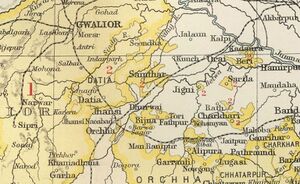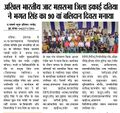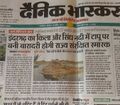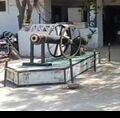Indergarh Datia
- For similar names see - Indergarh


Indergarh (इन्दरगढ़) is a town in Datia district in Madhya Pradesh.
Location
Its geographical location is |26|56|N|79|41|E. [1]It is situated at a distance of about 30 km in north-east of Datia town.
Origin
Indersen Jat of Dondaria founded the village and Fort.
Jat Gotras
Old Name and Jat gotra
It is believed that the name of this village was earlier Dard which later became Indergaon. The ruler of Indergaon was Indersen Jat. He constructed a strong fort here, that gave this place the name Indergarh. The Jat rulers were of Dondaria gotra. Lt. General Khem Karan Singh was also from this clan. That time it was centre of collection of revenue of 58 villages. [2][3][4]
Demographics
As of 2001 India census, Indergarh had a population of 14,596. Males constitute 54% of the population and females 46%. Indergarh has an average literacy rate of 63%, higher than the national average of 59.5%: male literacy is 71%, and female literacy is 53%. In Indergarh, 16% of the population is under 6 years of age.
Villages in Indergarh tahsil
1. Amawali, 2. Anandpur, 3. Andora, 4. Badehari, 5. Bagpura, 6. Bagurdan, 7. Bahera, 8. Baina, 9. Bandapara, 10. Barabuzurg, 11. Barguwan, 12. Barjorpura, 13. Basith, 14. Bhadol, 15. Bhadona, 16. Bharroli, 17. Bharsula, 18. Bilaspur, 19. Binori, 20. Birsingpura , 21. Chadhraua, 22. Chakdhanoli, 23. Chakkbena, 24. Chakunchiya, 25. Chapra, 26. Chhenkuri, 27. Chhikau, 28. Chimghan, 29. Chitai, 30. Dabhera, 31. Danguchad, 32. Degawangoojar, 33. Delua, 34. Dhanoli, 35. Dhimaryau, 36. Dhirpura, 37. Dohar, 38. Durgapur, 39. Fatepur, 40. Gohana, 41. Govindnagar, 42. Husenpura, 43. Ikona, 44. Itarora, 45. Jaitpura, 46. Jaroli, 47. Jaswantpur, 48. Jaswantpura, 49. Jiginiya, 50. Jonia, 51. Joura, 52. Jujharpur, 53. Kanjoli, 54. Katapur, 55. Khadaua, 56. Khaikheda, 57. Khajoori, 58. Kherichachu, 59. Kheridevta, 60. Kherona , 61. Kheronaghat, 62. Khiriya, 63. Khirka, 64. Kudari, 65. Kudra, 66. Kulenth, 67. Kurra, 68. Kuthonda, 69. Laharakalan, 70. Laharawed, 71. Loch, 72. Lodhipura, 73. Mahonajat, 74. Mau, 75. Murgawan, 76. Nandana 77. Nimona, 78. Pacherabuzurg, 79. Pachokhara, 80. Pachorakhurd 81. Padri, 82. Pahadirawat, 83. Pahadishyam, 84. Parsondagoojar, 85. Peepri, 86. Piparua, 87. Pipra, 88. Ramdeva, 89. Ramgarha, 90. Ranipura, 91. Raruajiwan, 92. Raruarai, 93. Ronni, 94. Roora, 95. Seguwan, 96. Senthri, 97. Seoni, 98. Sikari, 99. Silori, 100. Simthara , 101. Sunari, 102. Sundarpura, 103. Surapara, 104. Syawari, 105. Teekar, 106. Theli, 107. Tigra, 108. Tigroo, 109. Tiletha, 110. Toda, 111. Uchad,
History
Raja Balwant Singh (Doderiyan Jat clan) in about 1650 A.D founded the Jat State of Indargarh. He is reputed to have had an ancestral patrimony around Shivpuri, some 65 miles West of Gwalior. Whether he emigrated under duress from Shivpuri or brighter prospect abroad beckoned him, or was enticed away from his native Shivpuri by promise of a larger patrimony by the Bundela Chiefs of Orchha and Datia, still remains an enigma. What however is unambiguous is that. Raja Balwan Singh's new principality in the Trans-Sind Region initially comprised some 40 villages along the South Bank of the Sind in the intervening tract between Datia and Seondha. As the principality of Datia was relatively weaker than that of Pichor, it is to be inferred that the principality of Indargarh may have been utilized as a convenient buffer by the Bundela chiefs to constrict Pichor's expansion South of the Sind. This stratagem might even have had the tacit acquiescence of the neighboring Kushwaha ruler of Narwar, who was actuated by a similar design towards Pichhor. Whether the tale is true or apocryphal is however difficult to discern. There is on the other hand no tradition of any enduring internecine feud between the neighboring Jat principalities of Pichhor and Indargarh. It is however probable that with the interposition of kindred Jat principality as a buffer, the subsequent expansion of Pichhor was deflected Westwards beyond Bhitarwar in the Narwar territory and southeastwards towards Lahar and Daboh.
Raja Balwant Singh was succeeded by his son Indar Singh who further enlarged his patrimony and built a stone fort, still extant, which even now perpetuates his name and memory. The principality of Indargarh remained unimpaired during Aurangzeb's and some of the later Mughals' reigns, but had rather a precarious existence during the ascendancy of the Marathas in the 18th century A.D. During this period, the ruler of Indargarh was sometimes constrained to side with the Marathas, the allies of the Bundela Chief, but when left uncoerced joined forces with the neighboring Jat Chiefs of Pichhor and Gohad to resist the Southern intruders. After the demise of Pichhor in 1816 A.D, the Jat principality of Indargarh was also obliterated by the connivance of the Marathas in the beginning of 1817 A.D. and its ruler like his kinsmen of Pichhor and Gohad forced into exile. After the fall of Indargarh all the Jat forts have remained untenanted in this region; staggered in a line between Bhind and Jhansi, they are now like a row of avenging ghosts rather than abodes of patricians of yesteryears.
Indergarh Fort
Indergarh is located about 30 kms from datia on Datia-Lahar road. The fort is located inside the town. Raja Balwant Singh (Doderiyan Jat clan) in about 1650 A.D founded the Jat State of Indergarh. Raja Balwant Singh was succeeded by his son Indar Singh who further enlarged his patrimony and built a stone fort, still extant, which even now perpetuates his name and memory. The principality of Indergarh remained unimpaired during Aurangzeb's and some of the later Mughals' reigns, but had rather a precarious existence during the ascendancy of the Maratha's in the 18th century A.D.
It is a huge fort but now most of it is encroached,also the many buildings inside are in absolute ruins.Due to its location it has a commending view of the surrounding area.Due to internal fights within the Jat rulers one of them sought the help Scindia to settle the score ,and in return awarded them a small part of kingdom,by 1820 the whole area was under Scindia control.
Source - Motorcycling to Kamad Fort, Alampur, Indergarh Fort and Datia Chhatris by Jaywalker72
-
Main entrance of the Indergarh Fort
-
Remnants of old paintings of the Indergarh Fort
-
Remnants of old paintings of the Indergarh Fort
-
Indergarh Fort
-
Indergarh Fort
-
Indergarh Fort
बुंदेलखंड में जाट इतिहास
ठाकुर देशराज[5] ने लिखा है ....[पृ.550]: मध्य भारत के पड़ोस में बुंदेलों का देश है। जो बुंदेलखंड के नाम से मशहूर है। बुंदेलों से पहले यहां खंगार और जाटों की भी रियासतें थी। प्रसिद्ध गढ़कुंडार के अधिपति खंगार थे और इंदरगढ़ के मालिक जाट थे।
इंदरगढ़ के मातहत एक समय 84 गांव थे। इस राज्य को खत्म करने के लिए बुंदेलों ने कई बार कोशिश की किंतु वह सफल नहीं हुए क्योंकि यहां का किला जिसके चारों और पानी की गहरी खाई थी और परकोटा पक्का और काफी उत्साह और मजबूत था। उसे सहज ही जीत लेना आसान न था। आखिर उन्होंने दतिया को अपनी राजधानी बनाया और यही से बैठकर इंदरगढ़ के जाट अधिकारियों से युद्ध जारी रखा। इंद्रगढ़ का अंतिम बहादुर अधिपति जाट वीर दलपति था, जिसके बारे में यहां पर लोकोक्ति मशहूर है कि “दलपतियारे दलपतिया। अढ़ाई टटू से हराई दतिया।“ इंदरगढ़ का जाट घराना जबरिया गोत्र1 का था।
नोट - 1. जबरिया गोत्र का उल्लेख किसी अभिलेख में नहीं है। लेफ्टिनेंट जनरल खेमकरण सिंह का गोत्र दोंदेरिया था। उन्होने इंदरगढ़ के जाट शासकों के बारे में खोजपूर्ण लेख लिखे हैं। इससे स्पष्ट होता है कि इन शासकों का गोत्र दोंदेरिया था। Laxman Burdak (talk) 22:22, 14 January 2018 (EST)
इंदरगढ़ का किला राज्य संरक्षित स्मारक
दिनांक 18अप्रैल 2022 को वर्ल्ड हेरिटेज डे पर इंदरगढ़ का किला जिला दतिया को राज्य संरक्षित स्मारक घोषित किया गया है ।
Gallery
External links
See also
References
- ↑ http://www.fallingrain.com/world/IN/36/Indergarh.html
- ↑ Randhir Singh Ruhal: "Indergarh", Jat-Veer Smarika, Gwalior. 1992, p. 54
- ↑ Madhya Pradesh district Gazzeteer, 1977
- ↑ Pothi jagga, Jagannath Haselia, Tonk, Rajasthan
- ↑ Thakur Deshraj:Jat Jan Sewak, 1949, p.550
Back to Jat Villages


















